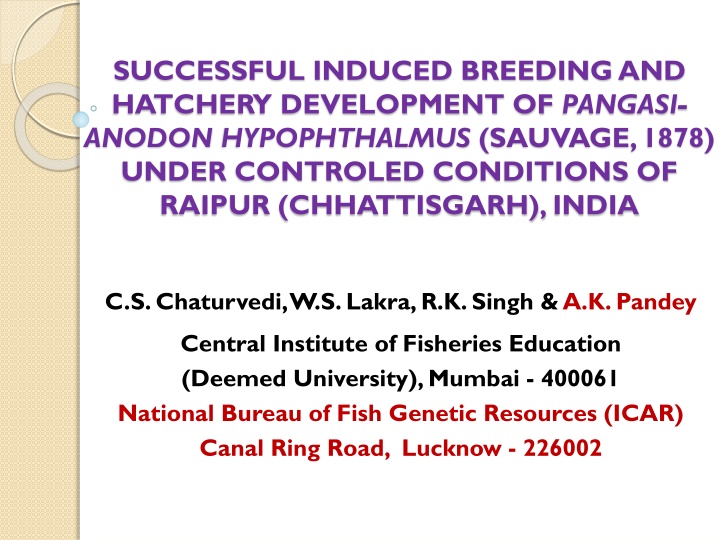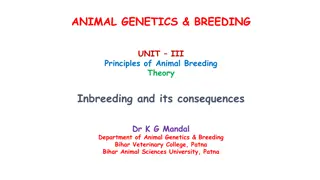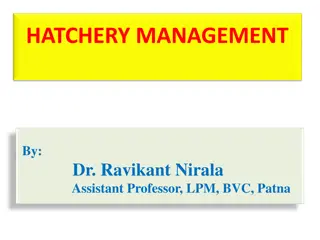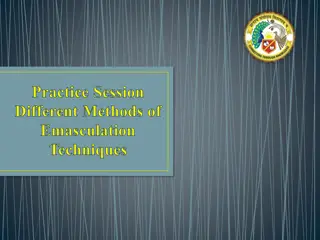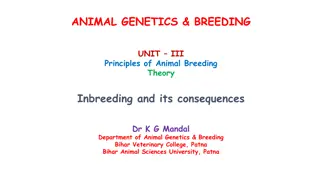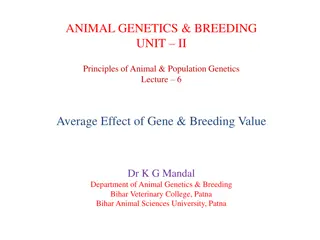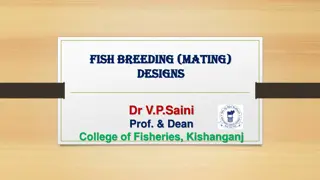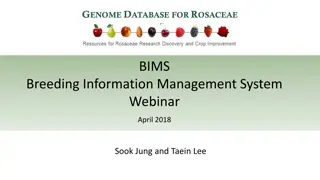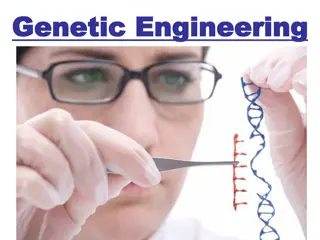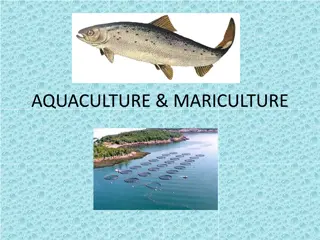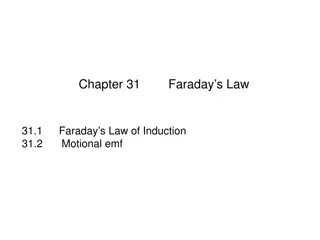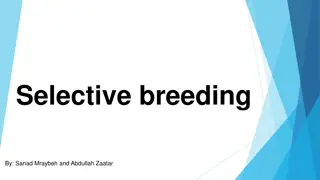Successful Induced Breeding and Hatchery Development of Pangasianodon Hypophthalmus under Controlled Conditions
Pangasianodon hypophthalmus, also known as striped catfish, has gained popularity in aquaculture markets. This species, native to Southeast Asia, has shown promising potential for freshwater catfish culture, with high demand for its white fillets in various countries. The article discusses successful induced breeding and hatchery development of P. hypophthalmus in Raipur, India, aiming to standardize the breeding protocol for enhanced production.
Download Presentation

Please find below an Image/Link to download the presentation.
The content on the website is provided AS IS for your information and personal use only. It may not be sold, licensed, or shared on other websites without obtaining consent from the author.If you encounter any issues during the download, it is possible that the publisher has removed the file from their server.
You are allowed to download the files provided on this website for personal or commercial use, subject to the condition that they are used lawfully. All files are the property of their respective owners.
The content on the website is provided AS IS for your information and personal use only. It may not be sold, licensed, or shared on other websites without obtaining consent from the author.
E N D
Presentation Transcript
SUCCESSFUL INDUCED BREEDING AND HATCHERY DEVELOPMENT OF PANGASI- ANODON HYPOPHTHALMUS (SAUVAGE, 1878) UNDER CONTROLED CONDITIONS OF RAIPUR (CHHATTISGARH), INDIA C.S. Chaturvedi, W.S. Lakra, R.K. Singh &A.K. Pandey Central Institute of Fisheries Education (Deemed University), Mumbai - 400061 National Bureau of Fish Genetic Resources (ICAR) Canal Ring Road, Lucknow - 226002
Introduction Pangasianodon known as striped (sutchi, iridescent shark) catfish, fetches high price in markets. Culture of this species is growing day-by-day in Bangladesh, Indonesia, India and Vietnam. Vietnam is the top producer and exporter of P. hypophthalmus. Contribution of the Indian major carps in the aquaculture of our country is more as compared to those of catfishes. hypophthalmus, commonly
In Andhra Pradesh itself, major carps contribute about 85% of the total freshwater fish production while catfishes and murrels show the next to them. P. hypophthalmus is native of river Mekong Basin and Chao Phraya river in Thailand, Cambodia and Vietnam. It has been introduced in Singapore, Philippines, Taiwan, Malaysia, China, Myanmar, Bangladesh, Nepal and India. In India, it was brought in West Bengal through Bangladesh during 1997. Initially, its culture was carried out in Andhra Pradesh and West Bengal in private sector but the Government of India permitted aquaculture of P. hypophthalmus in year 2010-11.
Young ones of the species are bottom feeder and carnivores while the fingerlings feed on snail, worm, insects, gastropods etc. Females of this species attain maturity at the end of third year while males mature in two years. P. hypophthalmus isa promising candidate species for freshwater catfish culture (young ones also possess ornamental values) and has captured all the markets of India in a short period. There exist reports that this species is being sold in more than 100 countries, mainly in European Union, Russia, South-east Asia and USA in the form of white fillets.
For culture of this species in West Bengal, the seed were initially Bangladesh. Though the specieshas been induced bred in West Bengal, Andhra Pradesh and Chhattisgarh and some hatcheries established in these states, the survival of offspring has been very poor. P. hypophthalmus ishighly fecund fish, seasonal spawner and breeds once in a year in flooded river. procured through
Recently, the striped catfish has been bred successfully in Mekong Delta region of Vietnam by using high doses of human chorionic gonadotropin (HCG). An attempt has, therefore, been made to induce breed P. hypophthalmus by employing GnRH-based drug and dopamine antagonist (ovaprim) in order to standardize the breeding protocol and development of hatchery for mass seed production of the species under agro-climatic conditions (Chhattisgarh). of Raipur
MATERIALS AND METHODS Breeding and hatching experiments were carried out at Lucky Fish Farm, Kurud, Dhamtari (Chhattisgarh State). Male and female brooders of Pangasianodon hypophthalmus (Sauvage, 1878) (Family Pangasiidae) were reared at M/S Hemant Chaudrakar Fish Farm at Dhamtari. At this farm, glass jar model of hatchery with 15 cemented vertical jars, was developed in the year 2010-11. Physico-chemical parameters of the water during the breeding experiments were analyzed as per APHA (1998).
For induced breeding, mature and gravid brooders of both the sexes of age group 3 (+) years were collected (Fig. 1, 2) and ovaprim was administered @ 0.5 ml/kg to females and 0.3 ml/kg males (Fig. 3). Injected brooders were kept in cemented breeding tanks of size (3 x 2 x 1 m) with flowing water. The stripping was done in the early morning (6 am) and after 10-12 hours of the drug injection as female were ready for spawning (Fig. 4).
RESULTS AND DISCUSSION Physico-chemical parameters of the water during the breeding experiments have been summarized in Table 1. Results of the breeding trails on P.hypothalamus conducted at Dhantari, Raipur (Chhattisgarh) have been summarized in Table 2. In present study, successful induced breeding was observed in the striped catfish after ovaprim administration. The eggs of P. hypophthalmus were very small (diameter 1.4- 1.8 mm), adhesive in nature while fertilized eggs were light creamy or brown in colour.
Table 1: Physico-chemical parameters during the breeding experiments. Sl. No. Parameters Date I 12.8.2010 II III IV V Remarks 14.8.2010 16.8.2010 17.8.2010 18.8.2010 1 Dissolved oxygen (mg/l) 4.2 4.0 4.8 4.8 4.0 Hatchery water 2 Free carbon dioxide (mg/l) -- -- -- -- -- -- 3 4 Iron (mg/l) Water temperature (Hatchery) pH Salinity (ppt) Total alkalinity (mg/l) 0.1 0.2 0.2 0.2 0.2 27.5 0C 27.8 0C 28.2 0C 28.4 0C 28.6 0C Hatchery water 5 6 7 7.4 -- 110 7.4 -- 110 7.8 -- 120 7.4 -- 120 7.4 -- 110 -- 8 Weather temperature (0C) 34.6 34.2 34.2 34.0 34.6 9 10 Weather Fertilization % (after removal of stickiness) Sunny 70% Sunny 60% Sunny 70% Sunny 80% Sunny 80% After stripping and washing of eggs
Table 2: Details of induced breeding experiments conducted on P. hypothalamus. Sl. No. Date Weight of female (kg) Wight of male Ovaprim dose (ml) Total number of eggs stripped Average number of fertilized eggs Fertilizat ion (%) Number of hatchlings Number of spawn Number of fry (nursery) 1 12.8.2010 3.200 3.500 1.5- 3.0 10,00,000 8,00,000 70 5,60,000 2,30,000 10,50,000 fry 6,30,000 fingerlings 2.800 2 14.8.2010 3.500 4.00 2.0-3.5 8,00,000 7,00,000 60 4,20,000 3,36,000 3.700 3 16.8.2010 4.100 3.200 1.6-3.8 12,00,000 10,00,000 70 7,00,000 3,40,000 3.400 4 17.8.2010 4.000 3.700 1.7-3.9 11,00,000 8,00,000 80 6,40,000 3,84,000 3.800 5 18.8.2010 3.900 4.200 1.1-2.0 10,00,000 7,00,000 80 5,60,000 2,24,000 4.100 Total 40,00,000 28,80,000 15,14,000
Rearing of hatchling were carried out in circular incubation pool, hapa (20 x 5 x 1 m) and nursery ponds. Survival of the seed varied from 40-60% in all the three conditions. For fertilization of one million eggs of P. hypothalamus, one ml milt was used. After fertilization, three type of solutions such as cow milk (Fig. 5), multani soil (mitti) (Fig. 6) and black soil (Fig. 7) were used for removal of stickiness of eggs.
Separated eggs were transferred to vertical jar cemented Pangas Hatchery for incubation (Fig. 8, 10) where they hatched out in 26 hours at 28 10C. Hatching in each set varied from 40-80% depending up on the maturity status of the brooders, stripping technique, hatchery management etc. After absorption of yolk, spawn started feeding on day 3 and live feed (zooplankton, Artemia naupli) and eggs along with custard powder were provided thrice daily as feed and shifted to prepared nursery ponds. Rearing of fry was done in the cemented cistern (3 x 2 x 1 m), happa (20 x 5 x 1 m) (Fig. 9) and three nursery ponds of different sizes (30 x 60 m, 40 x 60 m and 50 x 50 m, water depth 2-3 feet) @ 200-300 fry/meter2. The fry attained 4-5 cm size in 25-30 days and 7-9 cm in 40 days of rearing in nursery ponds. For culture of P. hypothalamus, fingerlings were stocked @ 25,000-30,000/ha.
Induced breeding of the Indian major carps has been achieved successfully by administration of pituitary gland extract (PGE) and different preparation of synthetic GnRH-based drugs and dopamine antagonists. Even catfishes have also been induced bred preparations/drugs. There exist report that the striped catfish has been bred successfully in Mekong Delta region of Vietnam by using high doses of human chorionic gonadotropin (HCG) (Bui et al, 2010). We successfully induced bred P. hypothalamus through ovaprim administration under agro-climatic conditions (Chhattisgarh) with better survival of fry and fingerlings. through the similar of Raipur
There exists a lot of scope for freshwater catfish farming in India for diversification of aquaculture and sustainable production. Since the culture of P. hypothalamus is more profitable among the catfishes, there exist more demand of this species for aquaculture in India and tropical regions of the America. Vietnam has shown the record production (1.0-1.5 million tonne per annum) of P. hypothalamus Though the striped catfish is widely cultured in China, Vietnam, Thailand, Taiwan, Philippines, Cambodia, Indonesia, Lao People's Democratic Republic, Bangladesh, Nepal and India, this species has been declared Endangered in Vietmam due to over-exploitation, habitat degradation, changes in flow and water quality as well as over- harvesting of eggs, fry and juveniles for aquarium trade.
The success achieved in induced spawning and seed (10,50,000 fry and 6,30,000 fingerlings) production of P. hypothalamus through ovaprim administration and hatchery development (Chhattisgarh) will pave the way for mass seed production of this species for conservation aquaculture which will reduce the pressure on collection of fry and juveniles from the wild natural habitats. in Raipur
Breeding set of P. hypothalamus. Collection of brooders of P. hypothalamus.
Stripping eggs of P. hypothalamus. Intramascular injection of ovaprim.
Washing of eggs with multani soil. Washing of eggs with cow milk.
Washing of eggs with black soil. Transfer of fertilized eggs of P. Hypothalamus.
Rearing of spawn of P. hypothalamus Pangasius Hatchery at Raipur
ACKNOWLEDGEMENTS The authors are grateful to Dr. Dilip Kumar, former Director, Central Institute of Fisheries Education (ICAR), Mumbai and Dr. V. K. Shukla, Director, State Department of (Chhattisgarh) for constant support and encouragement. Thanks are also due to Shri Hemant Chaudrakar for providing the facility for carry out the work. Fisheries, Raipur
